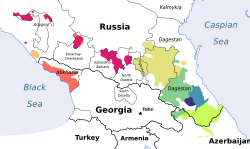| Tindi | |
|---|---|
| Идараб мицциIdarab mittsi | |
| Pronunciation | [idarabmitsːi] |
| Native to | North Caucasus |
| Region | Southern Dagestan |
| Ethnicity | Tindi people |
Native speakers | 4,500 (2020 census) [1] |
Northeast Caucasian
| |
| Language codes | |
| ISO 639-3 | tin |
| Glottolog | tind1238 |
| ELP | Tindi |
 Tindi | |
 Tindi is classified as Definitely Endangered by the UNESCO Atlas of the World's Languages in Danger | |
Tindi is a Northeast Caucasian language spoken in the Russian republic of Dagestan. Tindis have no individual designation for their language, but those living in the village of Idar call their language Idarab mitstsi meaning 'the language of the Idar village'. It is only an oral language; Avar or Russian are used in written communication instead. [2] Tindi vocabulary contains many loanwords from Avar, Turkish, Arabic, and Russian. [3] It has approximately 4,500 speakers. [1]

